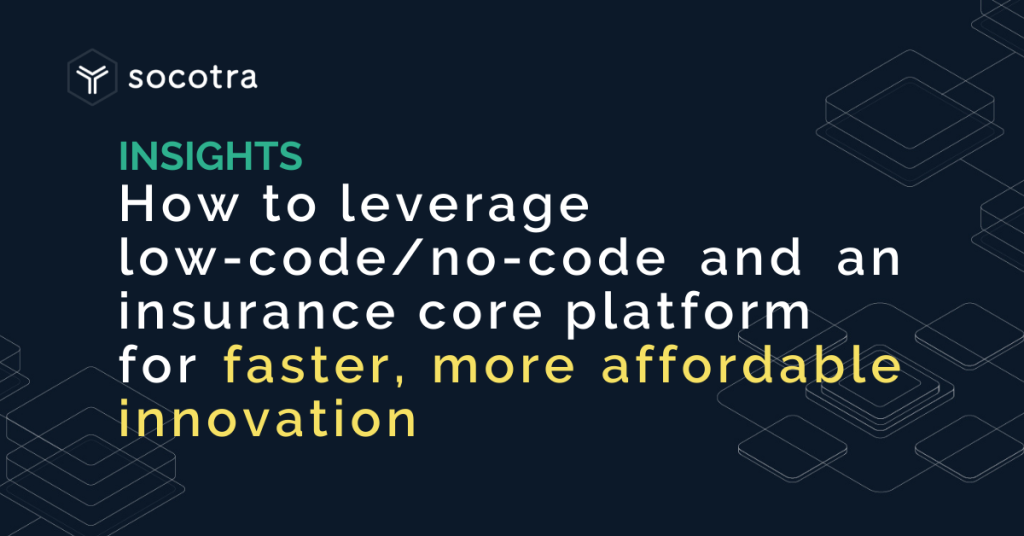How to leverage low-code/no-code and an insurance core platform for faster, more affordable innovation

As consumers continue to demand better products and services, insurers face greater pressure to accelerate the pace of innovation to stay competitive. But with limited IT resources, these companies may be tempted to adopt low-code or no-code development platforms to shift product configuration work onto business teams.
While low-code/no-code platforms are often touted for their ease of use and ability to improve productivity, they can’t make an insurer’s entire vision a reality or replace an insurance core platform when it comes to the speed and flexibility of launching an insurance product. The good news is that insurers can combine both to maximize their innovation. Leveraging a low-code/no-code platform to develop digital frontend experiences and an insurance core platform for powerful backend capabilities can help insurers bring truly novel products and exceptional customer services to life.
In this article, we’ll demystify the differences between low-code/no-code and insurance core platforms and how insurers can leverage both with a best-of-breed approach.
What’s the difference between low-code/no-code development platforms and insurance core platforms?
Low-code development platforms are designed to help users build custom applications without having to know programming languages like Python or Java. Instead of writing code, non-technical users can use a visual interface with pre-built components, such as drag-and-drop features, to create basic applications.
Low-code development platforms are sometimes confused with no-code development platforms. While both enable users to create applications without coding, no-code development platforms do not allow developers to “go under the hood” and write custom code, which limits the user’s ability to or alter the behavior of pre-built components, create workarounds, and ultimately meet technical requirements. For insurers, no-code platforms do not offer the industry-specific functionality needed to launch an insurance product or service policyholders, which means they’ll have to either design it themselves or wait for the component to be added to the platform’s roadmap in the future (if it’s even added at all).
Insurance core platforms are purpose-built to meet the needs of the modern insurer. These platforms securely store mission-critical policyholder data, enable insurers to easily configure and launch insurance products, and come with out-of-the-box modules and essential functionality for managing the entire policy lifecycle, including underwriting and rating, policy administration, billing, claims, and reporting. If the platform is cloud-native, updates are automatic and continuous with zero downtime or costs, giving insurers instant access to the latest insurance-specific features and security enhancements.
Accelerating speed-to-market with an insurance core platform
Many insurers look to low-code/no-code platforms to get to market faster, guided by the assumption that business analysts can launch entire insurance products without having to rely on developers. What these companies may not realize, however, is how much time and resources it takes to scope, design, build, deploy, maintain, and update the powerful backend functionality required to manage the end-to-end policy lifecycle.
Low-code/no-code is best suited for developing and automating low-complexity applications and workflows like frontend user experiences. But the essential workflows for underwriting and rating, policy administration, billing, claims, and reporting are often unstructured and open-ended, requiring complex logic that would take business users an immense amount of time and effort to develop. On top of that, building differentiated products always requires going “under the hood” to develop integrations and unique services. Insurers that utilize low-code/no-code are often blocked from accessing the underlying code, which means they must wait for the vendor to make changes for them, which is expensive and time-consuming.
For insurers, it’s faster and more affordable to launch a product using an insurance core platform, which provides robust, industry-specific functionality straight out of the box. Business teams don’t have to waste resources recreating the wheel from the ground up and can instead focus on configuring flexible core insurance modules to fit their specific business needs.
In addition, a modern insurance core platform (like Socotra) can natively handle complicated, insurance-specific workflows, such as:
- Out-of-sequence endorsement processing
- Policy snapshots
- Automated product versioning
- Insurance-specific reports
- Uncommon payment schedules
- Retrospective rating
- Usage-based insurance processing
These advanced features are beyond the scope of what can be created using a visual interface. As a result, businesses that rely only on low-code/no-code platforms would still need to hire high-cost developers to spend years building out this complex but necessary functionality.
Combining low-code/no-code with an insurance core platform for better end-to-end experiences
While low-code/no-code lacks the flexibility and out-of-the-box capabilities to make an insurer’s entire vision a reality, it shines when it’s used to build digital frontend experiences, such as agent portals or customer-facing websites for quote and buy. These types of applications require straightforward logic and workflows, which a business user can easily design and build for a specific audience and end goal. And since there’s no off-the-shelf product that provides this functionality, it makes sense to custom develop these applications for differentiated experiences.
The good news is that insurers can seamlessly integrate digital frontend experiences built on low-code/no-code with the advanced backend functionality of an insurance core platform to create a powerful, end-to-end tech stack. By leveraging both platforms with a best-of-breed approach, insurers can deliver unique experiences and an innovative product built upon a robust foundation for mission-critical policyholder data.
Powering fast and affordable insurance innovation with Socotra
Socotra is the first truly modern insurance core platform powering the future of insurance. We provide an intuitive interface, open APIs, and out-of-the-box capabilities that empower both business and IT teams to:
- Quickly integrate digital frontend experiences and leading third-party apps and services
- Easily launch any insurance product no matter the location or currency, including usage-based and embedded insurance products
- Seamlessly manage complex policy workflows like out-of-sequence endorsements and retrospective rating
- Safely test, iterate, and deploy multiple versions of insurance products while managing the associated policy renewals automatically
Ready to power fast and affordable insurance innovation? Learn more about how Socotra’s data model helps insurers adapt at the speed of change.

